
CONTINUING a series begun on Avenue A earlier in the month, I decided to walk Manhattan’s lettered avenues from A to D (Brooklyn has the full panoply, with a few exceptions, from A to Z, while Staten Island has an unexplainable and incongruous Avenue B in Port Richmond (see it on this FNY page). While today’s Manhattan’s Avenue B runs only from East Houston north to East 14th, it did continue northward at one time — way up north, at the east edge of Yorkville, where Manhattan Island widens just enough to allow two north-south avenues east of 1st Avenue. One, York Avenue, used to be Avenue A, and an Avenue B was built between East 79th and 90th Streets. In 1890, a year that saw a lot of street naming changes in Manhattan (West End, Columbus, Amsterdam Avenues were all created) Avenue B became East End Avenue. Finding myself on East 14th and Avenue B after a brief swing through Stuyvesant Town after my northerly walk on Avenue A, I then turned south on Avenue B.
Prior to Stuyvesant Town’s construction in the late 1940s-early 1950s, Avenue B continued north through Manhattan’s “gas house district” to East 21st Street.
Here’s “Avenue B,’ from 1982. The Major Thinkers, with Pierce Turner and Larry Kirwan, were originally from Wexford, Ireland and immigrated to Alphabet City. After their breakup Kirwan, which whom I have occasionally corresponded, found fame with Black 47, named for the year of the Irish famine, 1847. In 2008, Kirwan wrote to me, after seeing a previous Avenue B page:
I used to live on Ave. B and 3rd Street and take my word for it, the neighborhood was quite dangerous. Still, it was home and I loved it. Should you want more information on the area, take a read of my “memoir”, Green Suede Shoes. It’s available in most big book stores or on line. I think it gives one of the most thorough and unsensational accounts of the old East Village. The song Ave B is the Place to Be was actually written in a rehearsal studio on Ave. B (roughly around 6th St.) Amazingly, the studio is still there. The NY Times did a piece on it some months back. It came from a jam between Pierce Turner, Thomas Hamlin and myself and was somewhat tongue in cheek. We released it in Ireland and went over there to promote the album, Major Thinkers. We had just returned (penniless as ever). Unbeknownst to us, someone had sent a copy to WLIR on Long Island. They played it on a Sunday night. It was immediately a hit with their listeners. We received a phone call from Lenny Petze of Epic/Portrait Records. I actually told him to fuck off, as I thought it was a friend playing games. But we signed with Portrait eventually. I still get letters from people about the song… oh well, another part of New York history.
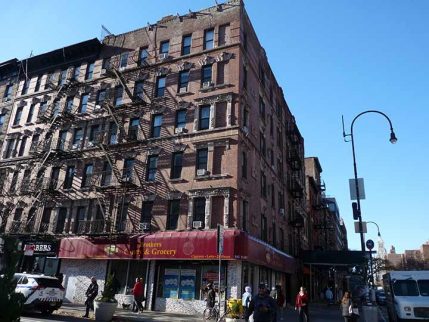 Looking west on East 14th from Avenue B. Much of the more ornate housing stock from 1890-1910 is still intact in Alphabet City. The freestanding “bigloop” lampposts are used only on 14th Street.
Looking west on East 14th from Avenue B. Much of the more ornate housing stock from 1890-1910 is still intact in Alphabet City. The freestanding “bigloop” lampposts are used only on 14th Street.
The unusually-named Saint Pizza and ReVision Lounge, both Avenue B between East 13th and 14th.
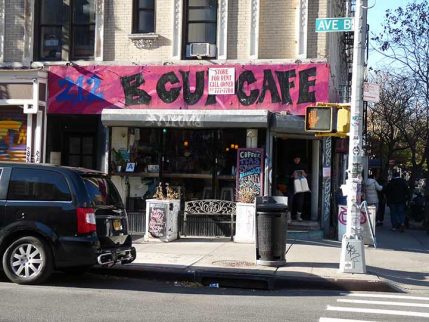 I am in the East Village for the fanciful sidewalk store signage, one of which is B Cup at Ave. B and East 13th. The blackboard sign in front has lettering reminiscent of 1960s psychedelic posters. It appears the coffee joint may not be here much longer, as the store is for rent.
I am in the East Village for the fanciful sidewalk store signage, one of which is B Cup at Ave. B and East 13th. The blackboard sign in front has lettering reminiscent of 1960s psychedelic posters. It appears the coffee joint may not be here much longer, as the store is for rent.
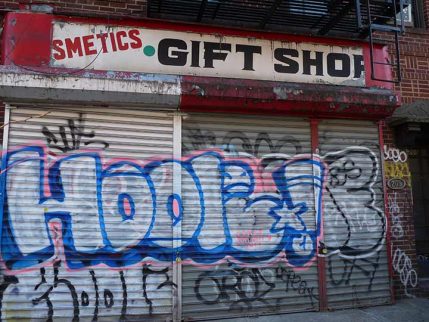 A very old sign, Cosmetics/Gift Shop, was uncovered when Raul’s Candy Store moved out. The store, which was an Avenue B fixture at #205 for 45 years, closed in 2019 when the longtime owners retired.
A very old sign, Cosmetics/Gift Shop, was uncovered when Raul’s Candy Store moved out. The store, which was an Avenue B fixture at #205 for 45 years, closed in 2019 when the longtime owners retired.
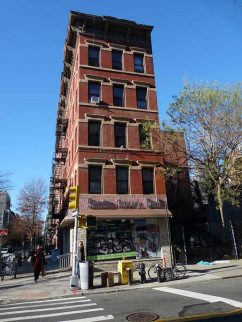
The Santa Grocery & Deli, Ave. B and East 12th, is “the place to be” given that the date I got the photo was December 14th. It was formerly the Santa Barbara Deli Superette.
 Maiden Lane, a cocktail bar (with seafood) at Avenue B and East 10th Street facing Tompkins Square Park, is nowhere near its namesake street in the financial district. Imitative of Manhattan, there are a number of Maiden Lanes in the metropolitan era, including Tottenville, Staten Island and what is now Mazeau Street in Maspeth, Queens.
Maiden Lane, a cocktail bar (with seafood) at Avenue B and East 10th Street facing Tompkins Square Park, is nowhere near its namesake street in the financial district. Imitative of Manhattan, there are a number of Maiden Lanes in the metropolitan era, including Tottenville, Staten Island and what is now Mazeau Street in Maspeth, Queens.
#151 Avenue B, between East 9th and 10th Street, stands out not only because its stoop and arched doorway seem more appropriate for a side street in this area, but because it was also the residence of Charlie Parker, who some consider the greatest jazz saxophonist and inventor of the bebop subgenre, from 1950-1955.
The Landmarks Preservation Commission designates many buildings not for architectural reasons, but for cultural and historic reasons, and this house is one of those occasions. You can find an LPC plaque mounted on the exterior.
In 1988, the Christodora House on Avenue B and East 9th was the focal point for what longtime East Village residents saw as a battle between the status quo with affordable rents and a future of the rich moving in and pushing them out, as it was one of the first buildings in the area to be redeveloped as a condominium. It had been built in 1928 {Henry Pelton, arch.] as a settlement house and had been used by community groups until that time, providing food, shelter, medical treatment and education to nearly 5000 locals every week. It had a third floor concert space where George Gershwin gave one of his first public recitals. Past residents include rock’s Iggy Pop and Law and Order actor Vincent d’Onofrio.
The original Christodora (“Christ gives”) Settlent House was founded. by Christina Isobel MacColl and her friend Sarah Carson in the Lower East Side in 1897.
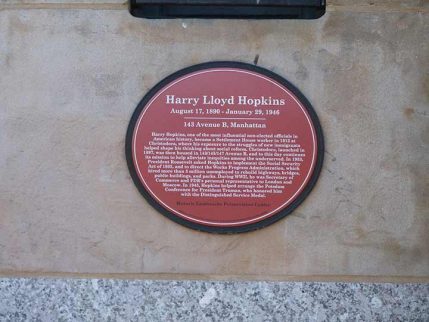 One of the coveted Historic Landmarks maroon medallions appears at the Christodora entrance, marking the former residence at #143 Avenue B of settlement house and public works pioneer and advisor to Franklin D. Roosevelt Harry Lloyd Hopkins.
One of the coveted Historic Landmarks maroon medallions appears at the Christodora entrance, marking the former residence at #143 Avenue B of settlement house and public works pioneer and advisor to Franklin D. Roosevelt Harry Lloyd Hopkins.
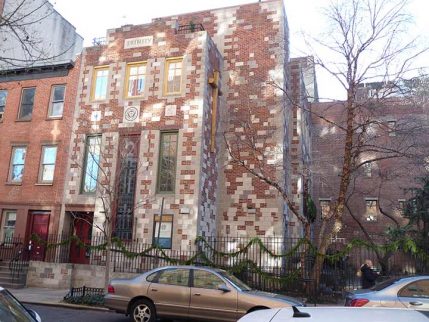
Trinity Lutheran Church, East 9th and Avenue B, has no connection with Trinity Church or Cemetery, which are associated with the Episcopal/Anglican Church, this is instead another remnant of Kleindeutschland, or the German settlement in the East Village. In the late 1800s and very early 1900s, German immigrants settled in the East Village between 3rd Avenue and the river, from Houston north to East 14th. After the General Slocum steamboat disaster, which killed over 1000 people, Kleindeutschland relocated uptown to what became Yorkville in the East 80s, which at the time was the hinterlands.
As a congregation, this Trinity was founded in 1839 with the first church building lasting from 1863 to 1975. The present building, with its variegated brickwork, went up from 1993-1996.
Given the harsh December shadows I found it hard to get photos of the venerable St. Brigid Catholic Church.
In the mid-2000s, it appeared that the church, built in 1848 and which had deteriorated to the point of no return, would be razed; however, an anonymous donor swooped in with a $20M donation which is paying for a good part of what has basically became a reconstruction job.
St. Brigid’s served a community of Irish dock workers in its early years:
The opportunities provided by the booming shipyards made the area a common landing point for Irish immigrants escaping the famine between 1845 and 1851. Plans were made for a Catholic church to serve this community, and in September 1848, the cornerstone was laid for St. Brigid’s (named for the patron saint of boatmen). Designed by Patrick Keely, a noted designer of churches, the building on the southeast corner of Avenue B and 8th Street was dedicated in December 1849. [East Village Transitions]
Compare St. Brigid’s restoration to what happened to St. Saviour’s Church in Maspeth, which was built by famed ecclesiastical architect Richard Upjohn in 1847. No angel appeared with a cash donation, and after the property was sold, it was disassembled and awaits a restoration…somewhere, someplace.
What was built in 1886, partially by Central Park co-designer Calvert Vaux, as the Children’s Aid Society Newsboys and Bootblacks Lodging House at Avenue B and East 8th, in 1928 became a school, Talmud Torah Darchei Noam, which is carved above the entrance. It’s the handsomest building on Avenue B, and as usual, Tom Miller, Daytonian in Manhattan, has intricate details…
The building was designed so that the boys could not enter without being subjected to an obligatory washing. Harper’s Weekly wrote in March 1886 that the “grimy little newsboys and their rivals in trade, the bootblacks, will be compelled to descend a flight of steps leading from the street into a little courtyard, from which they will gain access to the basement of the building, passing first into a large reception-room , and thence into a spacious and very useful wash-room adjoining, which is to be supplied with foot-baths, plunge-baths, and all necessary appliances for removing the traces of toil from the boys and fitting them to enjoy society.”
The synagogue moved out in 1974 and the building became derelict as the East Village collapsed around it. The building was renovated in 2003 and today houses luxury rentals.
Horseshoe Bar
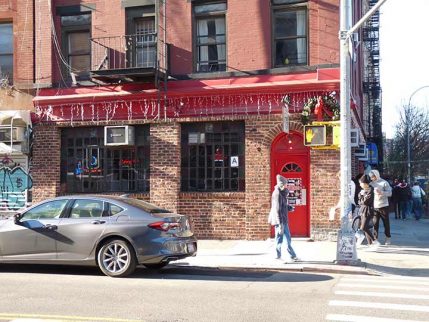
Unfortunately the painted ad for what is now the Peter Jarema Funeral Home on the 7B Horseshoe Bar Building at Avenue B and East 7th has been painted over and then replaced by a series of ads. “Vazac Hall” refers to a former Polish catering hall which opened in 1935. The interior bar is indeed horseshoe shaped. Village author Dawn Powell name checked it in her 1962 novel “The Golden Spur” and interiors have been used in the films Godfather II , Angel Heart, Crocodile Dundee and The Paper.
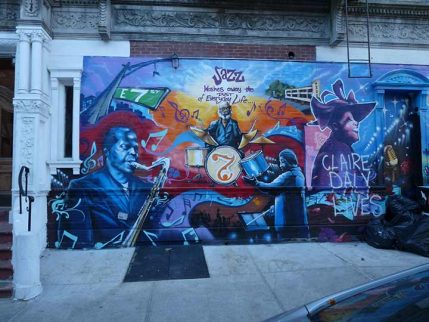 Mural on East 7th east of Avenue B featuring Charlie Parker, drummer Roy Haynes (1925-2024) and saxophonist Claire Daly (1958-2024)
Mural on East 7th east of Avenue B featuring Charlie Parker, drummer Roy Haynes (1925-2024) and saxophonist Claire Daly (1958-2024)
Next door at #184 East 7th, a pair of stylized griffins guard a faux-Corinthian columned entrance.
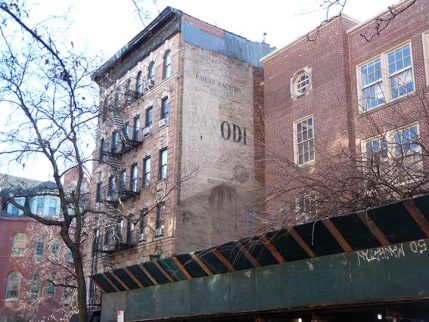 You’ll be forgiven if you think this “faded ad” for Parodi Cigars at #620 East 6th Street, visible from Avenue B, is the real deal. It’s faded and was painted long ago, but not for the purpose you think it was. Parodis are thin, hand rolled cigars, the kind Clint Eastwood smoked in his 1960s westerns. The company was founded on West Broadway by Quirino Parodi in 1913.
You’ll be forgiven if you think this “faded ad” for Parodi Cigars at #620 East 6th Street, visible from Avenue B, is the real deal. It’s faded and was painted long ago, but not for the purpose you think it was. Parodis are thin, hand rolled cigars, the kind Clint Eastwood smoked in his 1960s westerns. The company was founded on West Broadway by Quirino Parodi in 1913.
However this ad was painted in 1974 for Francis Ford Coppola’s Godfather II motion picture, in scenes in which Vito Corleone, fresh from Italy, sets up business in Little Italy and runs into trouble with the “godfather” who preceded him. Info: Ghost Signs, Clues to Downtown New York’s Past, Frank Mastropolo.
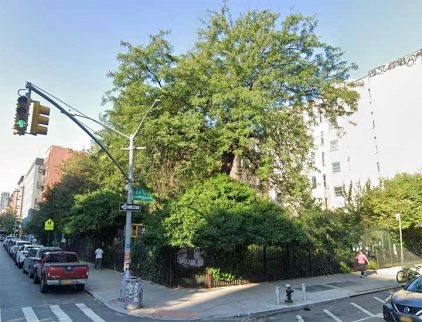 Though most of Alphabet City’s community gardens are found on Avenue C or on the side streets within sight of it, here’s the 6 and B garden: you can guess where it is. It’s also sone of the oldest, founded on the site of a teardown in 1983. Showing it in this view in September.
Though most of Alphabet City’s community gardens are found on Avenue C or on the side streets within sight of it, here’s the 6 and B garden: you can guess where it is. It’s also sone of the oldest, founded on the site of a teardown in 1983. Showing it in this view in September.
Here. East 6th Street is subnamed for Black LGBTQ activist Donald Suggs Jr. Meanwhile, Avenue B here is subnamed Avenues For Justice Way, honoring an anti-youth incarceration organization.
 What we’ve lost: the glorious Loew’s Avenue B Theater, shown here in 1940. According to Cinematreasures, “Movie mogul Marcus Loew erected it on the very site of the tenement building where he was born. Needless to say, his birthplace was demolished to make way for the luxurious 1,750-seat theatre, which was designed by Thomas W. Lamb and first opened on January 8, 1913, with vaudeville as its main attraction and movies thrown in just as fillers.” It later switched to movies exclusively and had been demolished by the 1960s.
What we’ve lost: the glorious Loew’s Avenue B Theater, shown here in 1940. According to Cinematreasures, “Movie mogul Marcus Loew erected it on the very site of the tenement building where he was born. Needless to say, his birthplace was demolished to make way for the luxurious 1,750-seat theatre, which was designed by Thomas W. Lamb and first opened on January 8, 1913, with vaudeville as its main attraction and movies thrown in just as fillers.” It later switched to movies exclusively and had been demolished by the 1960s.
Some more of the “casual elegance” of residential architecture from 1890-1910, at Avenue B and East 4th Street.
Those metal stars on the exteriors of #47-51 mark this row as quite old, perhaps the early 1830s or 1840s. They are not landmarked, so I’m not sure. As I have mentioned on a number of Forgotten NY tours, the stars aren’t decorative:
In many old brick row houses, floor and roof joists run from side to side, parallel to front and rear building facades. These beams connect to (often shared) party walls between buildings. Building fronts and backs, however, only connect at the edges and roof. So “the problem,” explains Ian Toner of Toner Architects, “is that sometimes these end walls can start to bulge outwards, since they’re only connected to the rest of the house at their edges,” which can increase the danger of catastrophic collapse. A combination of factors can exacerbate the problem, including poor-quality lime mortar, shifting foundations, gravity and time. The side walls aren’t immune from similar phenomena, but they tend to be more robustly joined to the structure. …Star bolts (and other shapes) are a common engineering retrofit, running through the brick and connecting facades to the joists behind the brick to stabilize things. [99% Invisible]
Interestingly, #47-49 have a marquee-like canopy above the entrance, handy when it’s raining and you’re fumbling for the keys.
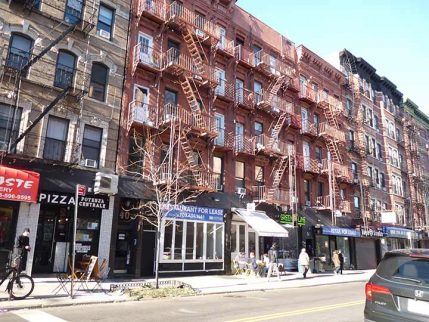 Some great “escapes” on Avenue B between East 3rd and 4th Streets
Some great “escapes” on Avenue B between East 3rd and 4th Streets
Some competing bars on Avenue B between East 2nd and 3rd: Mama’s Bar (where whiskey shots come with pickle juice) on the corner and the Hairy Lemon, on the site of former East Village touchstone Croxley’s Ales. Known as a Philly sports outpost, it’ll be jammed today (1/26/25) when the Eagles face the Washington football team in the NFC Championship Game. The signage color scheme is among my favorites, black and yellow.
The pub is named after Dublin’s Hairy Lemon. According to Visit Dublin, “The enigmatic Hairy Lemon Pub was christened in memory of one of the city’s great characters who was a dog catcher in the 1950s. He was reputed to boast a lemon shaped visage and a stubble of gooseberry like hair.”
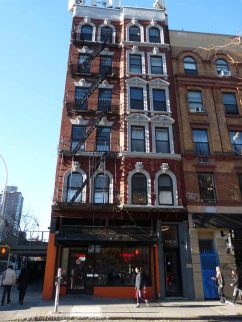
Where B begins: a 6-story walkup, fronted by The B, at #6, the lowest house number on the street.
Coming soon…Avenue C
As always, “comment…as you see fit.” I earn a small payment when you click on any ad on the site. Take a look at the new JOBS link in the red toolbar at the top of the page on the desktop version, as I also get a small payment when you view a job via that link.
1/26/25

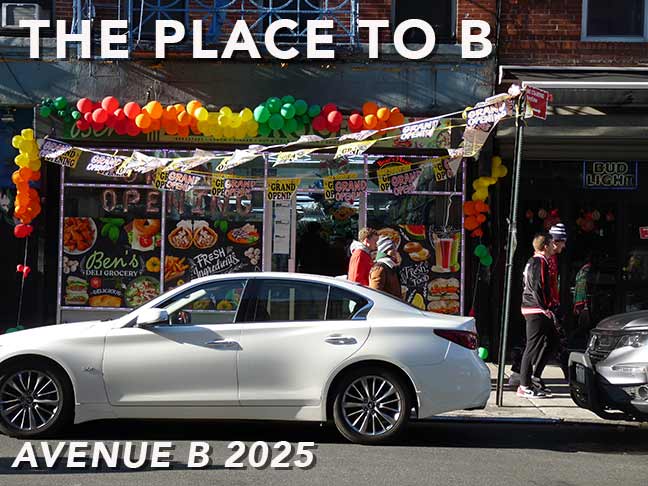
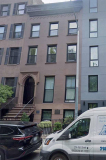
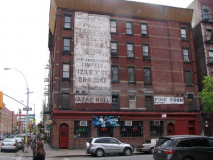
4 comments
Maiden Lane occupies the former location of the late, great and sorely missed Lakeside Lounge which had the best damned jukebox bar none.
I spent many nights knocking back beers there.
Lakeside Lounge was in the building next store over, Life Cafe occupied the Maiden Lane corner location for decades.
I managed the place for a few years.
Lakeside was a great dive bar and your spot on about the kickin’ jukebox.
I spent an afternoon round 2008 watching Van Morrison getting hammered & playing songs off the jukebox.
Good Times!
A small correction needed as I am a long time member of the 6 & B Garden (officially the “Sixth Street and Avenue B Community Garden). While we are one of the first volunteer run community gardens in the city, we are not the largest by far. Green Oasis, on 8th Street between C & D, is probably the same size as us with La Plaza Cultural, and the Ramos Garden (both on Avenue C and 9th Street) being larger. El Jardin del Paraiso on 5th Street between C & D is probably the largest as it goes thru the block to 4th Street. The East Village has the largest concentration of volunteer run community gardens in the city.
Fixed, thx. Normally I’d use a strikethrough for corrected copy, but this !@#$ new WordPress eliminated it…